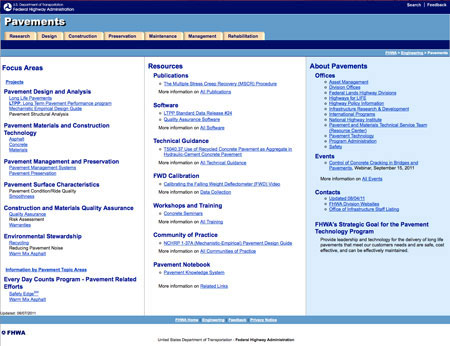U.S. Department of Transportation
Federal Highway Administration
1200 New Jersey Avenue, SE
Washington, DC 20590
202-366-4000
Focus
| Accelerating Infrastructure Innovations |
Publication Number: FHWA-HRT-11-016
Date: August 2011
Printable Version (.pdf, 1.3 mb)
As part of its ongoing national effort to improve the long-term performance and cost effectiveness of asphalt pavements, the Federal Highway Administration's (FHWA) Asphalt Pavement Technology Program has released two new Tech Briefs on the Superpave mix design system.
Superpave Mix Design and Gyratory Compaction Levels (Pub. No. FHWA-HIF-11-031) highlights the revolution in mix design brought about by the Superpave system. Developed through the Strategic Highway Research Program (SHRP) and first launched in 1993, Superpave is now the most widely used mix design system in the United States. The system introduced a new compactor, the Superpave gyratory compactor (SGC), for densifying mixes in the lab. Also introduced were new aggregate and binder requirements.
Despite Superpave's widespread success, some highway agencies have expressed concern that the asphalt mixes produced by the system's gyratory compaction levels can be too dry due to low asphalt binder content, resulting in durability issues. As noted in the Tech Brief, "the AASHTO [American Association of State Highway and Transportation Officials] Superpave gyratory compaction levels have proven to provide good-performing, constructible pavements in most cases." For cases where the current requirements may not be effective, the FHWA Mix Expert Task Group recommends that agencies perform an independent evaluation prior to making any adjustments in compaction levels from the AASHTO R 35 standards, "Superpave Volumetric Design for Hot-Mix Asphalt." The evaluation should look at the effect of the proposed changes in gyration level on performance for typical aggregates, binder, and mix designs. Superpave Mix Design provides guidance on conducting these evaluations, including examining the gyratory compaction level and binder content, considering the relationship of aggregate material properties to performance, evaluating mixtures, and conducting performance testing.
An overview of the gyratory issues that affect the performance of asphalt pavements is provided in Superpave Gyratory Compactors (Pub. No. FHWA-HIF-11-032). As highlighted in the Tech Brief, the primary operating parameters for the SGC include the pressure applied to the specimen during compaction, speed of gyration/rotation, number of gyrations applied to the specimen, and the angle of gyration. Values for these parameters were established during the development of the Superpave system under SHRP.
When all of these factors are properly calibrated, it was generally assumed that an SGC would produce hot-mix asphalt (HMA) specimens that have similar volumetric properties. However, this assumption has been questioned in recent years since procedures for calibrating the angle of gyration are unique to specific models of SGCs. FHWA led an effort to develop technology for a universal method of measuring the angle of gyration on all SGCs from inside of the specimen mold. These "internal angle" measurement devices have since been refined and are available from private manufacturers. As there are numerous potential sources of variability related to the production of a laboratory-compacted HMA specimen, however, Superpave Gyratory Compactors is designed to help practitioners address all of these various sources. The publication also provides a brief history of the development of concepts, practices, and equipment for measuring the internal angle of gyration, as well as the development of specifications for using internal angle measurements as part of routine practice.
Topics covered include use of the dynamic internal angle to calibrate the SGC, measurement of the dynamic internal angle using simulated loading, comparison of internal angle measurement systems, and the relationship between the internal angle and air voids for compacted HMA.
To download the Tech Briefs online, visit www.fhwa.dot.gov/pavement/pub_listing.cfm (click on "S" to see links to the publications).
For more information on the Superpave mix design system, contact the FHWA Asphalt Pavement Technology Team:
John Bukowski, 202-366-1287 (email: john.bukowski@fhwa.dot.gov)
Jack Youtcheff, 202-493-3090 (email: jack.youtcheff@fhwa.dot.gov)
Tom Harman, 410-962-0134 (email: tom.harman@fhwa.dot.gov)
To learn more about additional pavement topics, visit www.fhwa.dot.gov/pavement.

Information on the Superpave mix design system and other pavement topics is available at www.fhwa.dot.gov/pavement.